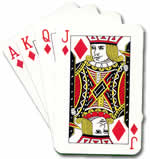Or search by topic
Number and algebra
Geometry and measure
Probability and statistics
Working mathematically
Advanced mathematics
For younger learners
Cunning Card Trick



 Shuffle a pack
of cards.
Shuffle a pack
of cards.
Look at the top card and place it face down on the table. Starting with one more than the value of the card (counting Ace as 1, Jack as 11, Queen as 12 and King as 13), count out cards on top of it until you reach 13.
For example, if the top card is a 7, place it face down on the table and then deal 6 cards face down on top of it, counting "8, 9, 10, 11, 12, 13". Of course, if the first card is a king you won't need any extra cards.
Look at the next card, place it face down on the table next to
the first pile and do the same thing.
Repeat until you have used all the cards in the pack and have a row
of small piles of cards on the table.
If you run out of cards before you complete the final pile, keep
the cards from that pile to one side to start your magic counting
pile.
Now gather up all but three of the piles and add them to your
magic counting pile.
(If you don't have one yet, these will form the pile.)
Choose one of the three remaining piles to be the secret
pile.
Look at the bottom cards of the two remaining piles and add their
values.
(So if, for example, the bottom cards are a Jack and a two, you get
11+2 =13.)
Count out that number of cards from your magic counting pile.
Now count out 10 more cards from the magic counting pile.
Finally, count how many cards are left in the magic counting pile, and look at the bottom card of the secret pile.
What do you notice?
Try again. If you like, you could use this trick to impress friends and relatives!
Can you explain how this delightful trick works?
You may also like
Painting Cubes
Imagine you have six different colours of paint. You paint a cube using a different colour for each of the six faces. How many different cubes can be painted using the same set of six colours?
Cube Paths
Given a 2 by 2 by 2 skeletal cube with one route `down' the cube. How many routes are there from A to B?

